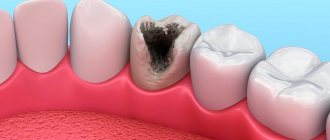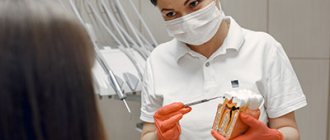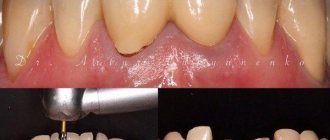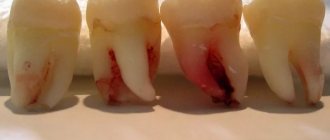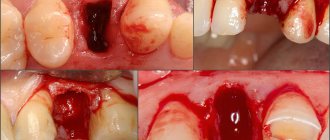Description
Tooth extraction is accompanied by bleeding, which most often stops after a few minutes with the formation of a blood clot. However, in some cases it does not stop on its own and continues for a long time - primary bleeding. Sometimes bleeding appears some time after the operation (several hours or even days later - secondary bleeding. Prolonged bleeding is most often caused by local causes, less often by general ones.
ICD code for alveolar bleeding
After tooth extraction (ICD 10 code: K08.1), the alveoli are naturally filled with a blood clot formed as a result of bleeding from a rupture of the dental artery, the network of arterioles and capillaries of the periodontium and gums. This bleeding is capillary and parenchymal in nature, usually occurs after tooth extraction and stops after a few minutes (from 5 to 20 minutes). The pressure of the gauze pad used to cover the wound helps to stop bleeding more quickly. Rinsing your mouth after tooth extraction prevents bleeding from stopping.
In some cases, bleeding in the area of the extracted tooth socket does not stop or stops and reappears after a few hours or even days. Typically, most bleeding after tooth extraction is caused by local causes: deep rupture and crushing of the gums, the presence of an inflammatory process, paralysis of the vascular walls after the use of adrenaline. Secondary bleeding associated with infection of the socket and disintegration of the blood clot are also observed.
In more rare cases, such bleeding is caused by general causes associated with blood clotting disorders (hemorrhagic diathesis and diseases with hemorrhagic symptoms). In most cases, bleeding after tooth extraction, due to reasons of both local and general nature, can be stopped using the generally accepted method - tamponade of the hole with iodoform gauze. Tamponade of the hole with iodoform gauze to stop bleeding must be done very carefully. To do this, blood clots are removed from the patient’s mouth and the bleeding hole is dried with a gauze swab in order to determine upon examination where the bleeding is coming from - from the alveoli or from the gums.
When bleeding from torn edges of the gums, after applying a hemostatic clamp to the gingival edge, it is enough to sew the gingival edges, trim or bandage the bleeding vessel. If bleeding occurs from the bone septum, then the bleeding area is compressed by squeezing the bone with bayonet-shaped forceps with non-converging cheeks. After this, the hole is tamponed.
ETIOLOGY AND PATHOGENESIS
The cause of bleeding from the tooth socket is tissue trauma, rupture of blood vessels (dental artery, arterioles and capillaries of the periodontium and gums) during operations in the maxillofacial area, most often tooth extraction or trauma. After a few minutes, blood clotting in the hole occurs and bleeding stops. However, some patients experience disruption of clot formation in the socket, which leads to prolonged bleeding. More often this is due to significant damage to the gums, alveoli, oral mucosa, pathological processes in the maxillofacial area (trauma, bacterial inflammation), less often - the presence of concomitant systemic diseases in the patient (hemorrhagic diathesis, acute leukemia, infectious hepatitis, arterial hypertension, diabetes mellitus). diabetes, etc.), taking drugs that affect hemostasis and reduce blood clotting (NSAIDs, antiplatelet agents, anticoagulants, fibrinolytic drugs, oral contraceptives, etc.).
With prolonged bleeding, the patient's condition worsens, weakness, dizziness, pale skin, acrocyanosis, decreased blood pressure and a reflex increase in heart rate appear.
If the patient was administered a local anesthetic drug with epinephrine, which has a vasoconstrictor effect, when its concentration in the tissues decreases, the vessels dilate and stopped bleeding can resume, i.e. Early secondary bleeding may occur. Late secondary bleeding occurs after several hours or days.
Titles
Post-extraction bleeding.
Classification, features of the course of the disease
Pathology is classified into primary and secondary bleeding. The first group is bleeding that developed immediately after tooth extraction, secondary bleeding - after some time. Approximately 65-94% of all cases occur in the secondary group, which is divided into early and secondary late types.
Externally, bleeding is manifested by the following signs:
- the blood from the hole does not stop, it can pulsate;
- feeling unwell;
- pressure is reduced;
- dizziness appears;
- rapid pulse;
- the skin becomes pale in color.
Alveolar pain (alveolar pain)
Most patients experience alveolar pain in the area of the extracted tooth after the anesthesia wears off. Its intensity is moderate and it gradually disappears. In other patients, after the anesthesia wears off, pain occurs when the tongue touches the gum in the area of the extracted tooth, while eating, or while brushing teeth. Along with this, a number of patients suffer from constant intense pain that does not stop for several days, debilitating the patient. The mechanism of occurrence of these pains is different.
- The appearance of pain after the cessation of the anesthetic is a natural reaction to tissue injury: biologically active substances are released, which are specific irritants for pain receptors.
- The occurrence of aseptic inflammation in the wound. It is a necessary link in the process of reparative regeneration and is also accompanied by the release of biologically active substances. Pain of moderate intensity appears within 1-2 days after tooth extraction.
- The pain that occurs when the tongue touches the surgical area while eating, talking, or brushing teeth is caused by mechanical irritation of pain receptors (often by the sharp edge of the alveoli).
- Constant intense pain, debilitating the patient, is characteristic of a purulent-inflammatory process with a pronounced necrotic component.
- Pain caused by the presence of sharp edges of the socket, movable fragments of the edge of the socket that have retained their connection with the gum.
Clinical picture of alveolar pain
Complaints of pain that occurs while eating, talking, brushing teeth, touching the tongue to the gum in the area of the extracted tooth. Upon examination, the edges of the gums in the area of the socket of the extracted tooth are of normal color or slightly hyperemic, the socket is filled with a blood clot, and the process of epithelization is in progress. When palpating the gums, a protrusion in the area of the edge of the socket or mobility of a fragment of the edge of the socket is determined. Sometimes the protruding edge of the interradicular septum may be palpable. Palpation of the listed formations causes pain.
Treatment of alveolar pain
Treatment of alveolar pain is carried out under local infiltration anesthesia. Treat the surgical area with an antiseptic solution. Using a narrow thin rasp, the gums are moved away from the alveolar edge, creating access to the edges of the alveoli. If a movable fragment of the alveolar edge associated with the gum is discovered, it is removed. The edges of the alveoli are examined and palpated, using a sharp curettage spoon or bone nippers, bone protrusions are removed and the edges of the alveoli are smoothed. If there is a protruding interradicular septum, it is partially removed using bone pliers. The surgical wound is treated with an antiseptic solution, and the gum is placed in its original place. In the absence of inflammation, the edges of the gums can be brought together with a suture. In the presence of inflammatory phenomena, solcoseryl can be injected into the alveoli in the form of a gel. A gauze swab soaked in an antiseptic solution is applied to the surgical area for 20-30 minutes.
The patient is prescribed analgesics and applications with a warm herbal decoction.
Prevention
Prevention of the development of this complication is the removal of the protruding edges of the alveoli, interdental and interroot septum directly during the tooth extraction operation.
Causes
Local causes of alveolar bleeding: damage (rupture, crushing) of soft tissue and bone vessels during traumatic surgery; fracture of the alveolar wall or interradicular septum; the presence of an intraosseous vascular tumor; during an acute inflammatory process (inflammatory hyperemia), in the second phase of the action of vasostrictors (vasoparesis), during purulent melting of a blood clot and thrombi in the vessels during alveolitis. Common causes of prolonged post-extraction bleeding are due to a violation of the blood clotting process or a violation of the vascular system. These include hemorrhagic diathesis: hemophilia, thrombocytopenic purpura (Werlhof's disease), hemorrhagic vasculitis, hemorrhagic angiomatosis (Rendu-Opeler disease), angiohemophilia (Villebran disease), C-vitaminosis, diseases accompanied by hemorrhagic symptoms: acute leukemia, infectious hepatitis, septic endocarditis, typhus and typhoid fever, scarlet fever and; in patients receiving anticoagulants, in patients suffering from hypertension.
Local factors
- Ruptures or injury to soft tissues. These are the most common causes of alveolar hemorrhages.
- Destruction of a blood clot formed in the socket. This can be caused by the actions of the patient himself, for example, active rinsing of the mouth, and alveolitis that develops as a result of infection of the socket.
- Damage (fracture) of the alveoli or bone septum located between the teeth.
- Opened vascular tumor in the area of the extracted tooth.
- Inflammatory process in periodontal tissues of various etiologies.
This is interesting: Neuritis and trigeminal neuralgia: symptoms, treatment, medications
High blood pressure
A patient with hypertensive pathology often experiences bleeding from the socket, so if he has such a disease, he should inform the doctor about it before the operation. This will allow you to find an individual approach to a problem patient and prevent possible complications.
Poor blood clotting
If the patient has previously been diagnosed with coagulation disorders, then he is obliged to inform the doctor about the existing problems in order to prevent negative consequences.
Inflammation of the socket
After surgery, the doctor must treat the hole with an antiseptic. But even treatment is not always a guarantee that the bleeding will stop after wisdom teeth are removed. If the socket is a source of infection, the gums usually bleed. In such cases, you should not resort to self-medication, as this can lead to dire consequences. Only a professional specialist can correctly diagnose and prescribe effective treatment.
Purulent accumulations
Before performing any manipulation, the dentist must diagnose the patient’s jaw and make sure there are no pathologies. If there are already purulent accumulations inside the gums, this can provoke heavy bleeding, which is quite difficult to stop.
Damage to the integrity of blood vessels
Due to the irregular growth and location of wisdom teeth in hard-to-reach areas of the oral cavity, the removal of such units is considered a relatively complex dental procedure. Vessels are almost always damaged by surgical instruments. Usually, after several hours, the bleeding stops, but the patient may simply not feel pain due to prolonged exposure to the anesthetic. If large vessels are damaged during surgery, bleeding may occur later and in such cases you should not hesitate to visit the dentist.
Failure to comply with medical recommendations
A rather complex procedure is the removal of a wisdom tooth; bleeding can occur in every patient, even if the operation is performed correctly. The reason for this is improper wound care, which leads to a deterioration in the condition of the hole and the development of an inflammatory process.
General factors
Systemic factors causing alveolar hemorrhage include a group of diseases collectively called hemorrhagic diathesis. Their reasons may be different:
- Deficiency of certain proteins responsible for platelet hemostasis (thrombocytopathy and thrombocytopenia).
- Damage to the walls of blood vessels (Osler syndrome, hemorrhagic vasculitis, hemorrhagic telangiectasia, etc.).
- Bleeding disorders (fibrinolytic purpura, hemophilia, radiation sickness).
- Regular or temporary use by the patient of aspirin-containing drugs , fibrinolytics, anticoagulants.
A tendency to bleeding can also be caused by certain infections (typhoid, scarlet fever), liver pathologies (hepatitis, cirrhosis), diabetes mellitus, and changes in hormonal status.
Increased blood pressure may also be the cause of blood flow from the socket that does not stop. Moreover, this is one of the most common common factors of any hemorrhage, including alveolar hemorrhage.
Causes of bleeding
As a rule, hemorrhage (hemorrhage) occurs as a response to damage during soft tissue surgery or as a result of exposure to certain medications. Such problems usually go away within a few hours after the procedure.
If an ordinary tooth can be pulled out without much difficulty and a cotton swab applied to the wound, then removing third molars is much more difficult. During the manipulation process, it is often necessary to saw the crown of the tooth and pull it out in parts. With deep and curved roots, it is almost impossible to extract them without damaging bone and soft tissue.
In addition, there are also other reasons why the bleeding does not stop after a wisdom tooth has been removed:
- high blood pressure;
- mechanical injuries of a large vessel;
- the patient is taking blood thinning medications, for example, Heparin, Aspirin and others;
- low blood clotting;
- the use of anesthetics, after which the blood vessels dilate. This increases bleeding and slows down the process of clot formation;
- the presence of concomitant diseases can cause heavy bleeding. These include hepatitis, scarlet fever, leukemia, hemophilia and others;
- Overheating of the body or high physical activity immediately after removal increases the risk of hemorrhage.
If immediately in the postoperative period the patient abuses alcoholic beverages or smoking, bleeding can occur as complications.
If wisdom tooth extraction cannot be avoided, then the patient needs to understand that bleeding after such a procedure is a natural and normal process. But even with relative safety, the release of blood requires careful monitoring by both the doctor and the patient himself.
How long does bleeding last
Patients are interested in the answer to the question of how long bleeding lasts after tooth extraction.
Normal: from 10 to 30 minutes. It is during this period of time that the first blood clot should normally form, and the blood, accordingly, will clot and gradually stop. This should happen even if a complex procedure was performed, for example, a wisdom tooth was removed.
Pathology: prolonged bleeding after tooth extraction, which can last from several hours to several days. It is also impossible to call situations normal when the blood stopped in the dentist’s office, but at home it began to flow again, and not to ooze, but to be released in large volumes.
Duration of bleeding, normal limits
One of the frequently asked questions by patients who are about to have a wisdom tooth removed is how long does the formed socket bleed and what to do if the bleeding does not stop.
As a rule, after 10-15 minutes after surgery, a blood clot forms in the socket; in some patients, approximately 30-40 minutes may pass before the clot appears. Under no circumstances should this clot be removed, because it protects the wound from infection.
Deviations from the norm are situations where bleeding continues after returning home. But some patients worry in vain, mistaking ichor for blood. If the bleeding in most cases stops within 30-60 minutes, then the discharge of ichor from the wound can be observed for up to 12 hours or longer.
Ichor is a yellowish or colorless liquid with a small blood capacity. Each person may have a different intensity of discharge depending on the characteristics of the body, but in any case this is not a cause for concern.
If blood is released from the wound uncontrollably for a long time, you should inform the doctor about this without waiting for complications.
Diagnostics
Primary diagnostic methods:
- measurement of pressure level, pulse rate;
- external examination, examination of the oral cavity, tooth extraction sites.
During the examination, the patient will be asked questions about his health and the time of occurrence of complications. It is necessary to determine the cause of the problem, for example, whether the patient has eaten or drunk, or whether there is a fever. In some cases, differential diagnosis will be carried out to determine the presence of the following diseases - diabetes, hypertension, diathesis, hepatitis, leukemia during an exacerbation.
Differential diagnosis
The main goal of diagnosis is to differentiate local factors from systemic factors or the consequences of taking anticoagulant drugs. Questions to the patient help clarify the picture:
- what diseases does he suffer from?
- whether he is taking aspirin-containing drugs, oral contraceptives, NSAIDs and other drugs that cause a decrease in blood clotting;
- Have you had any difficulty stopping bleeding before?
To establish the exact cause of hemorrhage, it is necessary to exclude or confirm diseases that can cause coagulopathy:
- hemorrhagic diathesis;
- hemophilia;
- leukemia;
- liver cirrhosis or hepatitis;
- diabetes.
When differentially diagnosing alveolar bleeding, a blood test is usually required, and there is a need to involve a hematologist.
How to solve the problem at home
What to do if a similar situation arises with you or your immediate family? First of all, you need to assess the scale of the problem and the intensity of the bleeding. If it is really strong and does not go away for a long time, then you cannot hesitate; you cannot do without professional help and you need to visit a dental surgeon. Also, consulting a doctor is simply necessary in situations where the phenomenon was caused by systemic diseases of the body (diabetes mellitus, impaired hemostasis). If blood only oozes, then first aid must be provided. Let's look at local ways to stop bleeding.
Tampon application
Applying a tampon will help stop bleeding
You will need a regular sterile bandage. Make a fairly tight tampon from the bandage, then apply it tightly to the wound surface and bite. Despite the fact that such a homemade tampon should fit very tightly, it should not cause pain. How long does it take for the bleeding to stop in this case? You need to keep the bandage on for about 20-30 minutes; due to compression (squeezing) of the edges of the wound, improvements should occur during this period of time.
If the procedure is not beneficial, you can roll the gauze swab out of the bandage again and pre-moisten it with hydrogen peroxide (3%). Next, you need to repeat the procedure.
Application of cold
You can narrow blood vessels and stop bleeding with ice, as well as any product taken from the freezer. The main conditions here are to apply cold only externally, after wrapping it in a towel or any other soft cloth. Apply to the cheek from the side of the extracted tooth, leave for five minutes with breaks of 5-10 minutes. The total number of applications is 3-4 times.
This is interesting: What antibiotics to take after tooth extraction, rules of administration
Cold causes capillaries to constrict
Using a hemostatic sponge
Hemostatic sponge absorbs secretions
This is a material that professional doctors use in their practice (however, it is sold in pharmacies). It can be used according to the principle of tamponing the hole (i.e., exactly the same as in the first method). But applying the material has nuances: when soaked in blood, it immediately reduces its size, so you definitely need to take a fairly large piece of sponge. It is also necessary that the sponge sinks slightly into the hole after application. To place it, it is better to use thin tweezers. It is even better that all manipulations are performed not by you, but by one of the people nearby, otherwise you can easily injure the wound even more.
Normalization of blood pressure
It is advisable to do this even for those who do not have problems with blood pressure and do not suffer from hypertension, because... In stressful situations, such as tooth extraction, pressure can naturally increase. If the readings are high, then take the appropriate medication.
If the methods do not help, and the bleeding within 1-2 hours does not stop, then you need to consult a doctor.
How to stop bleeding
Many patients simply do not understand the complexity of wisdom tooth extraction and when bleeding occurs after the procedure, they do not know how to stop the bleeding. If blood leaks from the gums within a few hours, you can consult a dentist or try to stop it yourself at home.
First aid with gauze swabs
Immediately after pulling out a tooth, the dentist washes the hole, treats it with an antiseptic solution and applies a gauze swab. After 15 minutes you need to spit it out. If this is not done, then after half an hour bacteria will multiply in the blood accumulated on the tampon, and this increases the risk of the inflammatory process.
If bleeding continues after spitting out the tampon, you should make a new tampon from a sterile bandage or gauze, apply it to the gums, firmly clamp your teeth and hold for about 20 minutes. If blood continues to accumulate in the oral cavity, then the procedure with a tampon can be repeated, only now it needs to be slightly moistened in a solution of Miramistin or hydrogen peroxide.
Home Remedies
the blood does not stop after the wisdom tooth is removed by the dentist , then you can use a cold compress. You need to apply a bottle of cold water or a piece of ice wrapped in a cloth to your cheek for a few minutes. Cold relieves pain well, reduces swelling and promotes the rapid formation of a blood clot.
Tea leaves have good tanning properties. To stop bleeding, you can apply a pre-wetted and cooled black tea bag to the place where the tooth was pulled out for 10 minutes. Just don’t apply a hot bag, as the clot that has already formed may melt.
Medications
When the gums bleed after tooth extraction, it is worth purchasing hemostatic drugs at the pharmacy, for example, Dicynon or Etamzilat. The tablets begin to act within 20 minutes after taking them, but the full effect is observed after several hours.
If you experience severe pain, you can take a painkiller. If, after visiting a doctor, an inflammatory process is diagnosed, then a course of antibiotics cannot be avoided; only a specialist must prescribe a specific drug.
In order not to irritate the gums even more, special hemostatic sponges can be applied to the wound. They perfectly normalize coagulation, have an antimicrobial effect and stop bleeding.
When is it time to go to the doctor?
All home remedies for stopping bleeding after tooth extraction did not work, and you also notice other alarming symptoms: swelling of the mucous membrane, persistent pain (pain radiates to the head and other parts of the face), a lot of blood and you even have to spit it out, general weakness , increase in body temperature - do not hesitate to consult a doctor!
On a note! Did the situation take you by surprise at night? Find a 24-hour private clinic where services will be provided for a fee. Or go to the emergency room of a government institution, but do not forget to take your insurance card and passport with you. Sometimes government agencies may also require SNILS, which is not mandatory, but often becomes the subject of disputes with staff, especially when it comes to free treatment.
If you are going to get to the hospital in person, then do not drive, because... general weakness can lead to poor concentration. If you are not ready to get to the clinic on your own, you can call an ambulance and describe all the symptoms you have. Upon arrival, doctors will most likely try to tampon the hole with hydrogen peroxide, but if there is no result, they will take you to the appropriate department.
Treatment
Using surgical instruments, a blood clot is removed from the socket, it and the adjacent area of the alveolar process are dried, the wound is examined and the cause of the bleeding, its nature and location are determined. Bleeding from a damaged mucous membrane is stopped by suturing the wound, on the wound, ligating blood vessels or suturing tissue; bleeding from small vessels can be stopped by electrocoagulating them. If a bone vessel is damaged, it is compressed with forceps or another surgical instrument. After stopping the bleeding, the postoperative wound should be sutured. To stop bleeding from the depths of the socket, tamponade is performed using various means. The simplest and most accessible method of hemostasis is tamponade with iodoform gauze, which is removed from the socket no earlier than 5-6 days after the start of granulation of the socket walls. For tamponade of the hole, you can use hemostatic gauze “Oxycelodin”, as well as gauze impregnated with a solution of thrombin, hemophobin, epsilon-aminocaproic acid, ampher, and the drug caprofer. A good hemostatic effect is achieved by introducing absorbable biological hemostatic drugs into the socket: hemostatic sponge, fibrin film, cotton wool, foam, fibrin glue, biological antiseptic tampon (BAT), gelatin or collagen sponge.
Local therapy
Local treatment involves establishing the exact location of hemorrhage, antiseptic treatment of the wound, packing the hole, and suturing.
If the interradicular septum is bleeding , it is compressed with forceps, a tight tamponade is made with a gauze swab impregnated with iodoform-alcohol, and several sutures are placed on the hole with polyamide or catgut thread.
A gauze ball is placed on top, which the patient bites on. If after half an hour or an hour the bleeding stops, the patient is sent home. The tampon is removed from the wound after 4-5 days.
If the source of hemorrhage is damage to a large vessel , it is bandaged with catgut or polyamide thread, sutures are applied if necessary, a gauze swab is placed and pressed with teeth.
If stopping hemorrhage is unsuccessful, the patient is hospitalized and undergoes general hemostatic therapy, the type of which is determined by the specific clinical situation.
General methods
If local methods do not help stop the bleeding, this indicates a violation of hemostasis and requires laboratory tests for blood clotting and general hemostatic measures based on their results.
This can be an infusion, injections of coagulants and hemostatics, transfusion of red blood cells. With the development of pronounced inflammatory processes in the gums, antibiotics are prescribed.
The choice of hemostatic agents is very wide. The most commonly used are the following:
- Aminomethylbenzoic acid and its analogues - Ambien and Pamba.
The mechanism of action of these drugs is based on a decrease in activity and a decrease in the production of fibrinolysin in the blood, a component responsible for anticoagulant functions. Release form: tablets, solutions for intravenous and intramuscular administration, sponges intended for packing bleeding wounds. - Aminocaproic acid . A drug with the same mechanism of action as aminomethylbenzoic acid. It is taken orally and intravenously.
- Calcium gluconate and chloride . The therapeutic effect is provided by calcium ions, which reduce vascular permeability, have a hemostatic effect, and normalize blood clotting. Available in the form of solutions for intravenous and intramuscular administration and tablets.
- Etamsylate (analogue – dicinone). Coagulant and hemostatic. Stimulates the adhesion of red blood cells, reduces the permeability of vascular walls, and increases blood clotting function. Available in tablet form and solutions for intravenous and intramuscular administration.
- Vikasol. Contains synthesized vitamin K, which ensures blood clotting. It is produced in the form of solutions for intravenous administration and tablets.
- Ascorutin. Contains rutozoid (vitamin P) and ascorbic acid, effective as a means of combating vascular fragility, normalizing hemostasis.
Vitamin C injections, agents that stimulate regeneration, and non-steroidal anti-inflammatory drugs are also prescribed.
The most common cause of bleeding is increased blood pressure. Taking antihypertensive drugs in this case is a simple and effective way to stop bleeding.
Alveolitis
Alveolitis is a purulent infectious-inflammatory process in the periodontium of an extracted tooth. This is inflammation of the tooth socket, a widespread disease, which, according to various authors, accounts for 24–35% of the total number of all complications after tooth extraction.
Causes of alveolitis
The causes of alveolitis are traumatic tooth extraction, the presence of an inflammatory focus at the time of surgery, the presence in the wound of foreign bodies, fragments of roots and bone, granulation tissue in the periapical area, pushing infected dental plaque into the wound, the absence of a blood clot in the socket or its mechanical destruction if the patient does not comply postoperative regimen.
Clinical picture of alveolitis
Clinical picture of alveolitis:
- The leading symptom of alveolitis is pain, which appears or intensifies on the 3-4th day after tooth extraction. The pain is intense and constant, disrupting sleep and appetite.
- The general condition of the patient is disturbed due to debilitating pain and sleep disturbances.
- Low-grade fever and tachycardia corresponding to body temperature may be observed.
- The air exhaled by the patient has a putrid odor.
- The gums around the alveolus of the extracted tooth are hyperemic, swollen, and in places covered with fibrinous plaque.
- The alveolus of an extracted tooth may not contain a blood clot (“dry” alveolus), or may be partially filled with a loose gray clot. The walls of the alveoli are covered with a gray-dirty coating, its edges can rise above the gum.
- Regional lymph nodes are often enlarged, ovoid in shape, elastic in consistency, mobile, and painful on palpation.
Treatment of alveolitis
Treatment of alveolitis is based on anti-inflammatory therapy, removal of the disintegrated part of the clot from the tooth socket, fragments of the root, crown and creating conditions for tissue regeneration.
After local anesthesia has been performed, they proceed to treatment of the hole. Using a syringe with a blunt needle, a stream of warm antiseptic solution (hydrogen peroxide, furatsilin, chlorhexidine, potassium permanganate) is used to wash out particles of a disintegrated blood clot, food, and saliva from the tooth socket. Then, using a sharp surgical spoon, carefully remove the remains of a blood clot, granulation tissue, bone fragments, and teeth. After this, the hole is again treated with an antiseptic solution, dried with a gauze swab, powdered with anesthetic powder and covered with a bandage made of a narrow strip of gauze soaked in iodoform liquid, or an antiseptic and anesthetic dressing “Alvogyl” is introduced. BAP, a hemostatic sponge with gentamicin or kanamycin, and antibiotic pastes are used as a bandage on the hole. The bandage protects the socket from mechanical, chemical and biological irritants, while simultaneously acting antimicrobial.
Proteolytic enzymes
To cleanse the tooth socket from necrotic decay, proteolytic enzymes (trypsin, chymotrypsin, chymopsin) are used, which are dissolved in an isotonic solution of sodium chloride or in a 0.25% solution of novocaine (10 mg of enzyme in 5-10 ml of solvent). Enzyme therapy shortens wound healing time. The tooth socket can be filled with turunda with hydrophilic ointments (levosin, levonorsin, levomekol, miramistin, oflocaine, streptonitol, nitacid or 2% thiotriazoline) or moistened with an antiseptic solution (dioxidin), curiosin.
When treating alveolitis in patients with diabetes, it is recommended to inject turunda soaked in a solution consisting of 20 units of insulin, 5 ml of furatsilin 1: 5000 and 1 ml of a 5% solution of vitamin B1 into the cavity of the tooth socket.
Novocaine blockade of the mandibular nerve
Regional novocaine blockade of the mandibular nerve has a beneficial effect on the clinical course of alveolitis of the lower jaw. In general, all manipulations in the treatment of alveolitis must be carried out under local anesthesia, since the latter, in addition to the analgesic effect, has a beneficial effect on the course of the inflammatory process. For alveolitis, one of the types of physiotherapeutic treatment is used: fluctuarization, helium-neon infrared laser rays, local ultraviolet irradiation, magnetic therapy. Fluctuarization has an analgesic and stimulating effect. Laser therapy reduces vascular permeability, improves microcirculation, and provides analgesia. Irradiation of the hole with ultraviolet light has a pronounced antimicrobial effect. Magnetic therapy has an analgesic and anti-edematous effect. Non-steroidal anti-inflammatory drugs or analgesics are prescribed according to indications.
Prevention of alveolitis
In order to prevent alveolitis, the doctor must:
- Before tooth extraction, perform professional oral hygiene for the patient;
- comply with all successive stages of tooth extraction;
- make a revision of the hole, removing fragments of tooth and bone, bringing its edges closer together;
- when removing two or more adjacent teeth, apply sutures to the mucous membrane;
- carefully perform hemostasis;
- if there is no blood in the hole, fill it with iodoform turunda;
- recommend that the patient, after tooth extraction surgery, follow recommendations on diet and mouth rinsing.
The article was written specifically for the OHI-S.COM website. Please, when copying material, do not forget to provide a link to the current page.
Consequences of prolonged bleeding
If the bleeding does not stop for a long time after tooth extraction, many people become nervous and even believe that this can be fatal. Is it really? No one has ever died from blood loss after extraction, but patients have encountered other complications. Let's list them:
- poor health and weakness. Prolonged blood loss can cause dizziness, blood pressure drops, and pale skin.
- dry socket effect. A protective clot does not form on the wound, and it is susceptible to bacteria; food debris can get into it, which will rot,
- infectious and inflammatory process. Alveolitis, gumboil, osteomyelitis and phlegmon may develop. At the same time, the body temperature will rise, severe pain will be tormented, and pus may be released from the wound.
Interesting! In 2009, a woman died in the UK after having several teeth removed the day before. Reason: excessive blood loss. As it turned out, the woman hid from doctors the presence of a whole “bouquet” of diseases: cirrhosis of the liver, a blood clotting disorder.
“If you are planning any surgical operation, be sure to inform your doctor about all your existing diseases and individual characteristics. Then the specialist will draw up a treatment plan taking into account your health problems and select the necessary medications. This will help to avoid postoperative complications even if the removal was difficult and the patient has serious illnesses,” says A.V. Kryukov, dental surgeon with 12 years of experience.
Complications after wisdom tooth removal
Manipulations for the extraction of wisdom teeth should not be underestimated, since even if such procedures are carried out correctly, the patient may experience complications.
This is interesting: How to treat alveolitis of the socket after tooth extraction, treatment with antibiotics, symptoms photo
Edema
One of the most common consequences that occurs after tooth extraction is swelling. The reason for this may be partial damage to the tissues around the tooth. Usually the swelling goes away within 1-2 days. To speed up the elimination of swelling, this can be done by applying cold compresses to the cheek.
Fever
After a tooth is removed, the body’s natural reaction is to increase body temperature. This condition can last for 2-3 days. To improve your health, you need to take antipyretic drugs, but if the condition does not improve, you should immediately visit a doctor.
Soreness
Pain after extraction of the “eight” occurs due to damage to the periodontal tissues and nerves. If the pain cannot be tolerated, then for relief you need to take analgesics. When painkillers do not help, you should go to the dentist.
Suppuration of the socket
If the wound becomes infected, suppuration may occur. The reasons for the formation of pus may be non-compliance with medical recommendations and improper care of the oral cavity, as well as dental fragments remaining in the tissues after surgery. Self-medication in such cases is inappropriate; only a qualified doctor can prescribe adequate treatment and eliminate the cause of suppuration.
Dry socket
The blood clot must remain in the wound. It protects nerve endings and bone from microbial penetration. Therefore, on the first day after the manipulation, you should not rinse your mouth, and also do not eat hot food.
If a dry socket forms, this leads to increased pain, inflammation and alveolitis. In such cases, the doctor places a tampon with anti-inflammatory gel on the sore spot. Treatment continues until complete healing.
Preventive measures
Prevention of alveolar hemorrhage consists of fulfilling two main conditions.
- It is necessary to allow time for a blood clot to form in the hole , which will prevent bleeding. There is no need to rush to relieve the pressure on the cotton swab, much less get rid of it. If blood clotting is normal, it should be kept for at least 30 minutes.
- You cannot take actions that could destroy this clot. Such actions include eating hot food or drinks immediately after tooth extraction, vigorously rinsing the mouth, and brushing your teeth the first day after tooth extraction.
Precautionary measures
A wisdom tooth has been removed and the wound is bleeding – what to do in such situations? Hemorrhagic syndrome can be prevented with the help of hemostatic drugs, provided there are no contraindications.
In the first days after the manipulation, you need to brush your teeth with extreme caution and do not eat hot or hard foods. You should not stick your tongue into the hole, as such actions can damage the clot.
You should also avoid physical activity, visit the sauna, and take hot baths.
Before the procedure, you need to accurately and truthfully answer all questions asked by the doctor, especially about taking anticoagulants, aspirin and the presence of pathogenic diseases. Women do not need to hide the presence of menstruation and the use of contraceptives.
If you have high blood pressure or problems with blood clotting, you must notify your dentist.
Advice for the patient
What to do if you continue to bleed or start bleeding from the socket of an extracted tooth? First of all, prepare a tampon from sterile cotton wool/gauze, place it on the hole, press firmly with your teeth, and maintain this position for half an hour. Over time, the pressure on the tampon can be eased, but there is no need to rush to remove it.
While holding the tampon, you need to measure your blood pressure and, if necessary, take an antihypertensive drug.
You can speed up blood clotting by placing something cold on your cheek, such as a plastic bag filled with water and ice.
While fighting bleeding, you should not eat or drink anything. If it does not stop (this can be easily checked by the condition of the tampon), depending on its intensity, you need to go to the clinic yourself or call an ambulance.
The video provides recommendations from a leading dentist in case of bleeding after tooth extraction.
What not to do
To prevent the development of recurrent bleeding, the patient must adhere to the following rules for 48 hours. It is forbidden:
- Do heavy physical work, bend over and play sports.
- If stitches have been placed, spit and make active facial movements.
- Drink any alcoholic beverages and smoke.
- Injure the socket: drink drinks through a straw, chew on it, touch it with your tongue.
- Take a hot bath, steam in a sauna or visit a sauna.
- Eat tough and solid foods.
- Drink and eat hot (cold) drinks and meals for 3-4 days.
- Drink aspirin and drugs in which it is present.
- Warm (apply heat) the area of the extracted tooth.
- Chew gum.
Following these recommendations will help avoid the development of unpleasant consequences and promotes the proper formation and fixation of a blood clot in the vessel. It may take up to 3 months for the wound to heal completely.
How much should you not eat after extraction and why?
You should not eat immediately after pulling out a tooth; you should wait at least a few hours. While under anesthesia, the patient is not able to control the process of biting food, so he can damage his cheeks, lips, or even get burned without realizing it. You should refrain from eating solid foods and hot drinks. During the first three days, you can only eat soft, not too hot food, so as not to disturb the healing of the wound and not to endanger the clot that has formed in the hole.
If the bleeding does not stop, despite following all the rules for post-operative oral care and nutrition outlined by your dentist, contact your doctor or emergency services immediately.
Sources
- https://kiberis.ru/?p=32357
- https://eltransteh.ru/kod-mkb-pri-lunochkovom-krovotechenii/
- https://my-ort.ru/novosti/lunochkovoe-krovotechenie/
- https://berezkadent.ru/about/polezno-znat/krovotechenie-posle-udaleniya-zuba-mudrosti/
- https://anZub.ru/lechenie-zubov/krovotechenie-posle-udaleniya-zuba/
- https://mnogozubov.ru/krov-ne-ostanavlivaetsya-posle-udaleniya-zuba/
- https://dentist-pro.ru/xirurgiya/udalenie-zubov/kak-ostanovit-krov-posle.html
- https://StomaGet.ru/hirurgiya/kak-ostanovit-krov-posle-udaleniya-zuba
